
Fischer's chameleon, also known commonly as the Nguru blade-horned chameleon and the Nguru two-horned chameleon, is a species of chameleon, a lizard in the family Chamaeleonidae. The species is endemic to Tanzania.

The strange-horned chameleon, also known as Rwenzori plate-nosed chameleon or single welded-horn chameleon, is a species of chameleon. It is native to the rainforests of the Ruwenzori Mountains of western Uganda and eastern Democratic Republic of the Congo.
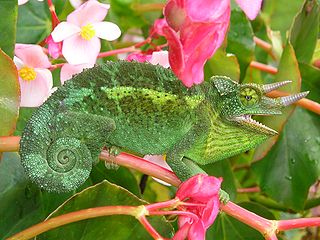
Jackson's chameleon, also known as Jackson's horned chameleon, three-horned chameleon or Kikuyu three-horned chameleon, is a species of chameleon native to East Africa, and introduced to Hawaii, Florida, and California.
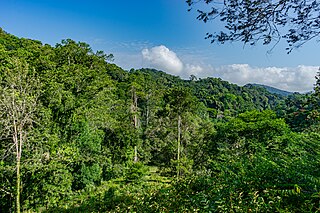
The Amani Forest Reserve, officially listed as Amani Nature Forest Reserve is a protected area located the Muheza and Korogwe Districts in the Tanga Region of Tanzania. The nature reserve was established in 1997 in order to preserve the unique flora and fauna of the East Usambara Mountains. The East and West Usambara Mountains are a biodiversity hotspot. The Amani Nature Reserve includes tropical cloud forest habitats.
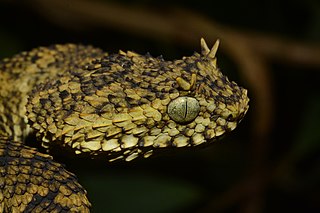
Atheris ceratophora is a venomous viper species endemic to a few mountain ranges in Tanzania. This used to be the only horned, arboreal viper known from Africa, until the discovery in 2011 of Atheris matildae, also found in Tanzania. No subspecies are currently recognized.

The Sokoke scops owl is a highly localized species of scops owl found in lowland forests of Kenya and Tanzania. The greatest population of this species of owl is in the Cynometra-Manilkara forest, which is less than one-third of the Sokoke Forest. It is also found in the Afzelia-Cynometra forest.

The Mazumbai warty frog is a species of frogs in the family Brevicipitidae. It is endemic to forests of the West Usambara Mountains of Tanzania where it is threatened by habitat loss. It is part of a species complex and was recognised as a separate species in 2004, having previously been included in Callulina kreffti.
The long-billed forest warbler, also known as the long-billed tailorbird, is a songbird of the family Cisticolidae, formerly part of the "Old World warbler" assemblage. It is found in Tanzania and Mozambique. Its natural habitat is subtropical or tropical moist montane forests. It is threatened by habitat destruction.
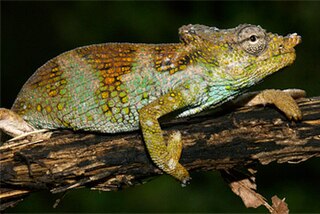
Kinyongia vanheygeni, the Poroto single-horned chameleon or Van Heygen's chameleon, is a species of chameleon, a lizard in the family Chamaeleonidae.

The West Usambara two-horned chameleon or West Usambara blade-horned chameleon is a species of chameleon endemic to the West Usambara Mountains of Tanzania. Until 2008, it was generally confused with Fischer's chameleon, which is not found in the Usambara Mountains. None of its close relatives occur in the same range as K. multituberculata, but K. matschiei and K. vosseleri are restricted to the East Usambaras.
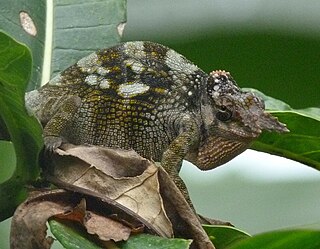
Kinyongia tavetana, the Kilimanjaro two-horned chameleon or Kilimanjaro blade-horned chameleon, is a species of chameleon in the genus Kinyongia. It is native to forests, woodlands, well-wooded gardens and plantations in the highlands of southern Kenya and northern Tanzania. Its type locality is Mount Kilimanjaro, but it is also known from Chyulu Hills and Mount Meru to the Pare Mountains.

The sharp-nosed chameleon is a chameleon native to the Uluguru and Udzungwa Mountains of Tanzania, where it inhabits forests, woodlands and plantations at an altitude of 1,400–1,900 m (4,600–6,200 ft) above sea level.
The spiny-flanked chameleon, also known as the spiny-sided chameleon, is a species of chameleon endemic to Tanzania. It was first described in 1932 by Arthur Loveridge.

Trioceros deremensis, the Usambara three-horned chameleon or wavy chameleon, is a species of chameleon that is endemic to forests in the Eastern Arc Mountains of Tanzania.
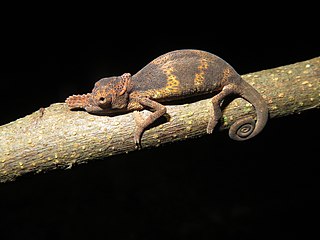
Kinyongia tenuis, also known as the Usambara soft-horned chameleon, Usambara flap-nosed chameleon and Matschie's dwarf chameleon, is a fairly small species of chameleon from Kenya and Tanzania.

Kinyongia boehmei, the Taita blade-horned chameleon, Böhme's two-horned chameleon and Dwarf fischer's chameleon, is species of chameleon, a lizard in the family Chamaeleonidae, found only in the Taita Hills of southeastern Kenya. It is the smallest species in the East African "two-horned chameleon" group and until 2008 it was generally considered a part of K. tavetana.

Kinyongia uluguruensis is a species of chameleon, also known as the Uluguru two-horned chameleon or Uluguru two-horned chamaeleon. It is endemic to highland forests in the Uluguru Mountains of Tanzania.

Kinyongia vosseleri, also known commonly as the Usambara two-horned chameleon and Vosseler's blade-horned chameleon, is an endangered species of lizard in the family Chamaeleonidae. The species is endemic to Tanzania.

The four-horned chameleon is a species of chameleon, a lizard in the family Chamaeleonidae. The species is native to highland areas in western Cameroon and southeastern Nigeria.




















